




In the first half of the 20th century before electricity arrived in the 1950s, the Craven Arms was gas lit, as it is today. At that time, the gas came from carbide produced on the premises. Older residents in the area recall the lights going dim and the landlord having to go round the back to put more water on his carbide! Up to 1926 the Court Leet was held at the Craven Arms, dealing with petty crimes in the area, and is likely to be the reason why the village stocks are located just to the left of the building
The Craven Arms dates back to the 16th century, with signs of earlier origins, and has retained its original features including original fireplaces, heavy low beamed ceilings and stone flagged floors. It was originally a farm house and probably developed into a public house over the years by the farmers’ wife brewing ale in the kitchen and selling it to drovers herding cattle sheep and geese to market and to passers by supplementing the family income. There was never any planning permission for it to be a pub as it just gradually came into being. The brew would have been ale, not beer, as the true meaning of ‘ale’ is a drink produced from barley alone without hops, which were not available or possibly not even heard of at that time. Further early additions were rooms with a “Horse & cart stop. Seen in the pictures below. The dining room was once the stables for the horses stopping by.
SIR WILLIAM CRAVEN – JUST LIKE DICK WHITTINGTON.
In the 16th century William Craven was born to a pauper’s family in Appletreewick. The Rector of Burnsall found him a job in London, and he travelled by cart to London where he rapidly worked his way up through his employers’ firm, eventually taking it over, making his fortune, and finally becoming Lord Mayor of London. On his return to Appletreewick he enlarged the High Hall, made the road from Appletreewick to Burnsall, built Burnsall Bridge, built Burnsall School, and repaired St Wilfrids church. He had an enormous influence on the area and his descendants became the Earls of Craven. The Craven Arms pub was part of his Estate and appropriately the heavy oak beam over the fireplace in the Cruck Barn came out of the High Hall during recent renovations. His story is that of Dick Whittington and his coat of arms still hangs over the front door, and hangs over the Cruck Barn fireplace and over the Dining Room and Tap Room fireplaces.

THE CRAVEN CRUCK BARN
The first to be built in the Dale for 300 – 400 years the Cruck Barn has been faithfully constructed using the same materials tools and methods used all those centuries ago. Meticulous research and attention to detail ensures it is as authentic as possible based on a now destroyed barn at nearby Barden.
The bent oak trees forming the crucks were donated by the Broughton Hall Estate and the ling heather was donated by the Bolton Abbey Estate from Barden moor just over the hill opposite the Craven Arms. Insulation is by sheep’s wool which can be seen above the roof timbers, and the walls are covered with traditional lime and horsehair plaster.
The Cruck barn was built by Robert Aynesworth, a member of the family who own the Craven Arms, together with a team of local people; even the tables were made only 200 yards away by local carpenter Jim Mason.
400 years ago there were no builders merchants and few people travelled more than 10 miles from home. They could only use what they could find in their immediate surroundings. In plentiful supply was stone and oak trees from the dense natural woodland which covered the area before it was cleared and heather from the moors. Stone slates had not yet come into being except for the very wealthy. If you needed a roof over your head there was no alternative to thatching with ling a long heather which grows on the moors. Straw or reeds were not available and would in any case not stood the climate.
.
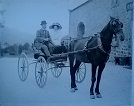

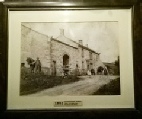
The stone had to be quarried and shaped by hand, and lime mortar was used produced in the numerous small lime kilns, the remains of which can be found in the area. The timber was cut by hand and riven (split) into the sizes and shapes required. Nails, which we take for granted, were expensive, as each had to be made by hand, so the timbers were held together by wooden pegs. The gathering of the heather from the moors was a laborious task pulling each piece out by the roots (a backbreaking job as they had no machinery to cut it) and the quantity required for each roof was enormous. The crucks are made from bent oak trees, selected by searching the woods, split down the middle with wedges to form two matching halves to create the A shaped cruck which extended virtually right down to the ground supporting the whole weight of the roof, unlike present day structures where the roof is supported by trusses resting on the wall tops. The cruck extending right down to the ground enabling a rectangular building was a natural progression from the earlier circular dwellings, where a single central pole from the floor supported the entire roof.
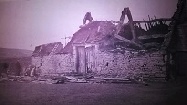
History of the Craven Arms
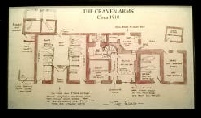
Plan of the pub around this time.
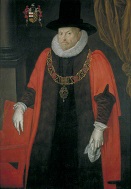
Willliam Craven -
Lord Mayor of London
Drawing of Barden Cruck Barn
by M Thomson
Barden Cruck Barn being dismantled before being rebuilt at Shibden Hall











